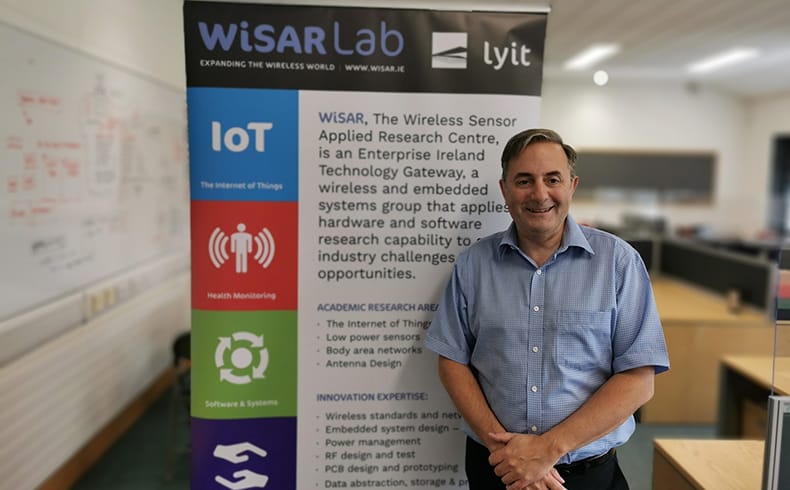In our ‘Meet the Team’ series, we bring you a range of staff interviews from across the Technology Gateway Network.
Today we introduce Stephen Seawright, Technology Gateway Manager at WiSAR, based in ATU Donegal. Stephen talks about his role, the importance of the Gateway presence in Donegal, benefits of working with the Gateway and the first steps to take when thinking about embarking on an innovation project.
Tell us a bit about the WiSAR Technology Gateway?
WiSAR stands for Wireless Sensor Applied Research, which in today’s vernacular means that we are an Internet of Things (IOT) research group. Based in ATU Donegal and established in 2008, WiSAR has a core team of full-time engineers with skills in electronics, wireless technologies and embedded software that routinely deliver practical product and system solutions to Irish industry. Since IOT is ubiquitous, we have clients over a wide range of sectors including manufacturing, health, leisure, retail, agriculture, marine and ICT.
Describe your role within the Gateway:
My role is customer facing, I provide companies with access to technology within ATU and within the wider Technology Gateway Network. I am fortunate enough to meet creative people regularly with new product ideas and aspirations to use technology within their business to develop a new product or service or to overcome a challenge. I help them scope out their idea, problem or opportunity and then decide on the best route forward. This can be a simple introduction to a knowledge expert or, more typically, will involve writing a funding application so that WiSAR can undertake a collaborative project with the company. I am then involved in keeping the project on track, making sure that contractual deliverables are achieved.
What’s unique about Gateway and its presence in Donegal?
The WiSAR Technology Gateway is the only national research centre in Donegal and one of the few Knowledge Centres in the North-West. As such, we are uniquely placed to provide a window into the world of “tech” available in ATU and beyond. We access capability far beyond our own research group so that we can create multi-disciplinary teams and provide clients with a complete solution. For example, we often leverage expertise from the Department of Computer Science in ATU. Due to the nature of the regional economy, we work mainly with start-ups and SMEs and have a reputation of delivering practical projects in a cost effective manner.
What are the main benefits for a company collaborating with WiSAR and the wider Technology Gateway network?
WiSAR is an experienced team embedded with a growing Institute of Technology. We have engineers who have been part of the group since its inception in 2008 providing stability for long-term clients and confidence to new companies that collaborate with us. We have a simple and transparent IP policy to promote collaboration and facilities to match industry needs. Within ATU, the Technology Gateway is the industry access point for R&D enquiries and is well placed to be an enabler to pull different disciplines into a given project. For example, often a good starting point for a new software project is to consider the User Experience and the User Interface or for some a project in Design Thinking is an appropriate starting point, both delivered by colleagues in Creative Media. Another aspect of our work is the ability to understand and leverage the expertise that exists nationally within the Gateway network. Where the skillset or discipline does not exist or is insufficient in ATU the Gateway manager is usually able to refer the company to an appropriate Centre within the network. We try not to turn any enquiry away.
What is the first step/s a company should consider when considering an innovation project?
Since a large number of our new clients tend to be start-ups I would recommend to find a co-founder early on that compliments your skillset and embark on the journey together. More generally, a company should talk to as many people as possible about the innovation idea before commencing the project. Talk is cheap. I see so many companies who embark on an expensive hardware or software development only to have re-engineer significant aspects of their prototype because they had not talked it through sufficiently. From an engineering perspective, the successful projects we see are those that take the time to develop a solid technical requirements specification at the outset.
For more information on WiSAR Technology Gateway, get in touch, check out the website or follow on Twitter, and LinkedIn.
